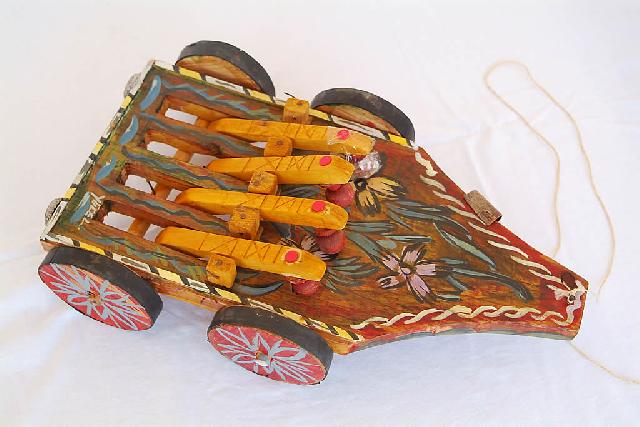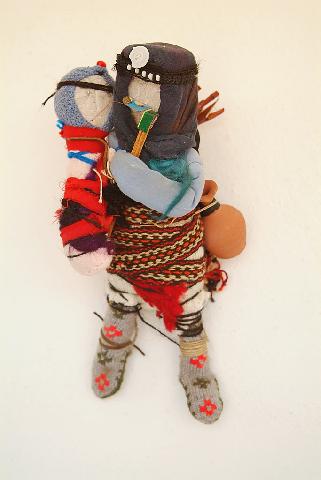
Please note: None of the material on these pages is hosted by the Turkish Radio's server. These are simply reference points for your convenience. To see the material at their original locations, right click on it and choose "Open Link in New Window".



Just in case you missed the article:
x0x Being a child in Anatolia
By SABIHA TANSUG
From clothes to toys... Being a child in Anatolia
Dolls in Anatolia are still decked out in
talismanic clothes, as they have been for
millennia. And children still chase after toy
wooden carts...
Everything is charming in miniature... Because its
cute, just like childrens clothes and toys, which
have been a focus of love and concern and a source
of joy and happiness in every society since time
immemorial. Before a baby is born, friends and
family members all enthusiastically knit, weave
and sew elaborately embroidered clothing so as to
wrap the naked body of the tiny infant in
mini-garments made with painstaking care in line
with traditional beliefs. Such clothes are
naturally shaped by the family environment as well
as by the customs, traditions, beliefs and
geography of their society. These millennia-old
traditions still persist today in Anatolia, cradle
of civilizations.
PATCHWORK: NOT FASHION BUT BELIEF
Talismanic clothing and evil eye beads are the
first thing that pop into mind at the mention of
childrens clothing in Anatolia.Such clothes, whose
origin pre-dates the rise of the monotheistic
religions, utilize a thousand and one different
materials and are designed to ensure that children
are healthy and long-lived. Such patchwork
clothing also expresses traditional beliefs.
Mothers, for example, who have lost children, make
patchwork clothes to protect their babies from
evil spirits. There is a belief that evil spirits
come in the night and that, as they struggle to
remove the layers of clothing piece by piece, day
dawns and they vanish into thin air.
Let us now relate one such story. There once was a
woman named Bahar Hatun whose babies died as soon
as they were born. This grief-stricken young
mother collected bits of cloth from seven families
that had been blessed with children and made from
them a variety of baby clothes.
Eventually Bahar Hatun gave birth to a beautiful
baby girl followed immediately by a boy.
While they were growing up she dressed both of
them in patchwork clothing and sang them
lullabies: May he sleep, may he grow / Sleep my
child, let my yearning arms hold you / May angels
be at your side every night / Drive away evil
spirits and watch over my little one.
And Bahar Hatuns babies grew up to be a fine young
woman and a strapping young man. And never, until
he was engaged to be married, did she cease from
making her sons cloak, waistcoat, and skullcap
from seven different scraps of fabric, or from
decking her daughter out in patches of cloth of
every color in the rainbow until she became a
bride.
WARDING OFF DISEASE
Such patchwork clothing is known in the local
parlance as "hastalik sasirtmasi" or warding off
disease. If you see a young person dressed in
patchwork in the village marketplace, you can be
sure that this is an expression of traditional
belief. A number of protective charms are also
attached to the babys clothes and caps to ward off
the evil eye:
seven-eye beads, evil eye beads, blue buttons,
seashells, coins, parts of birds, frogs and bone,
animal teeth, lumps of alum, black cumin and other
seeds, amulets, Mother Fatima or Mother Mary
hands, Armudiye charms, talismanic metal jewelry,
colorful tassels, and a myriad of embroidered
designs... All these charms can be seen lined up
on the soft undershirts made with fervent belief
and worn by children. Even the socks, booties and
rawhide sandals children wear on their feet are
carefully decorated. We can see even more
elaborate examples of such patchwork, which
continues to be worn today in some parts of the
world, in the clothing of children from Turkestan
and Uzbekistan.
FROM SILK SHIRT TO LIFE SASH
Another tradition that lives on today is that of
making the newborn babys first under garments from
bits of his fathers old underwear.
This is done to ensure that the baby, who is used
to his mothers smell from birth, becomes familiar
with his fathers smell and learns to love him as
well. Turning now to some examples,
babies were dressed for ceremonies in a shirt and
undershirt of crushed silk and a life sash that
was tied with green ribbons over the swaddling
clothes. Based on sacred belief, this sash
symbolized longevity for the boy or girl on whom
it was girded.
TOYS MADE OF WOOD
Anatolian toys, products of the creative human
intelligence and made of all natural materials,
are at the same time the fruit of a vast
traditional culture. Wooden carts for boys and
wooden cradles for girls made from thin tree
branches or the stalks of plants, and dolls and
puppets fashioned from wooden sticks and bits of
cloth, such toys not only provide children with a
wealth of fun but are also important for
developing their manual skills and creativity.
Talismanic clothing, evil eye charms, colorful
booties, soft undergarments, wooden toys... all
are words that seem to resound in our ears out of
the depths of history. Nevertheless, you can still
see such items in many parts of Anatolia today, on
baby clothes and on toddlers chasing after toy
wooden carts.
---
--
Recommended
Cook Books